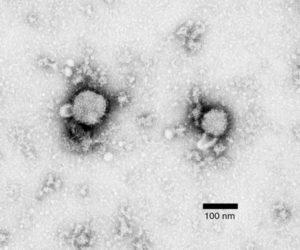
Methylamine tungstate negative-stain electron micrograph of arenavirus isolated from mouse spleen homogenate cultures that tested positive by immunofluorescence assay for lymphocytic choriomeningitis virus infection. Viral envelope spikes and projections are visible, and virion inclusions show a sandy appearance, indicating Arenaviridae. (Source: Foster et al., 2006 Emerg Infect Dis, Wikimedia Commons)
Majority of murine lymphocytic choriomeningitis virus (LCMV) infection studies are conducted in specific pathogen free environments. In reality, viral infections occur with other bacterial and/or fungal infections. The effect of CMV on bacterial co-infections has been extensively studied, however the reverse has not.
To shed light on how bacterial infection affects LCMV induced immunity, researchers infected mice with E.coli a day post LCMV infection. Straub et al., showed that E.coli results in significantly lower proportions of LCMV-specific T cells and higher LCMV burden compared with controls. This anti-LCMV immunity was mediated by indirect activation of NK cells by toll-like receptor ligands such as lipopolysaccharides (LPS from bacteria), resulting in suppression of T cells by NK cells in a perforin independent manner.
LPS induces innate cells to produce pro-inflammatory cytokines such as IL-15, a cytokine important for NK cell activation and survival. To determine if IL-15 is responsible for indirect activation of NK cells, researchers used monoclonal antibodies to block IL-15 activity in LCMV-E.coli co-infected mice. Interestingly, despite decreased proportions of NK cells due IL-15 depletion, NK cell mediated anti-viral activity was not affected. Illustrating that LPS-induced NK activity during LCMV-E.coli co-infection is also independent of IL-15 signalling. Finally, they showed that LPS-induced NK mediated killing of LCMV-specific T cells is not due to the activity of NK receptors NKG2D and NCR1, receptors previously shown to be important for killing T cells in LCMV (only) infected mice.
In summary, the study by Straub et al., demonstrates how bacterial co-infections can negatively impact anti-LCMV immunity and viral control. Where TLR stimulation leads to NK cell mediated suppression of virus specific T cells and LCMV control in a NKG2D and NCR1 independent manner.
Journal Article: Straub et al., 2018. Bacterial coinfection restrains antiviral CD8 T-cell response via LPS-induced inhibitory NK cells. Nature Communications
Article by Cheleka AM Mpande










